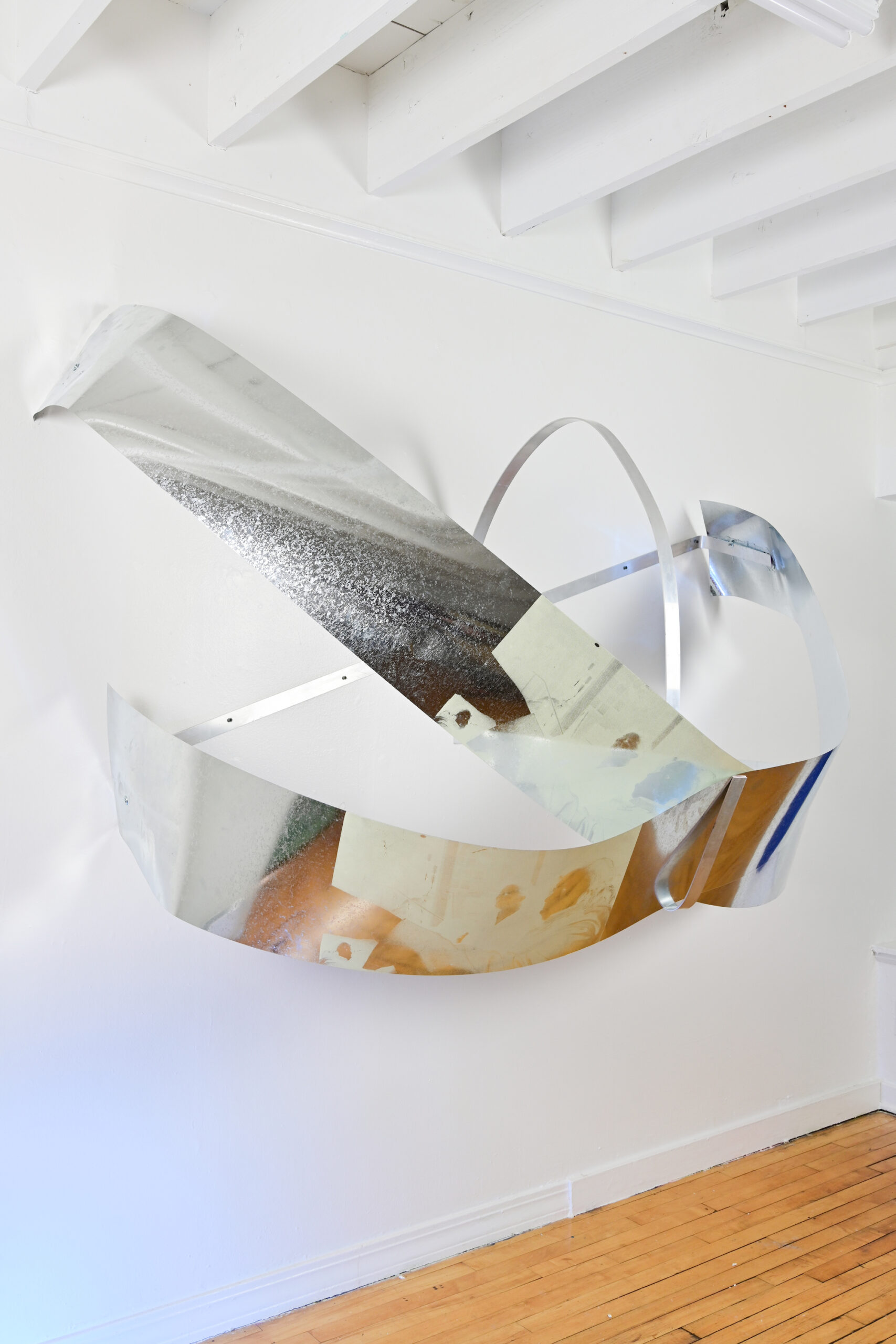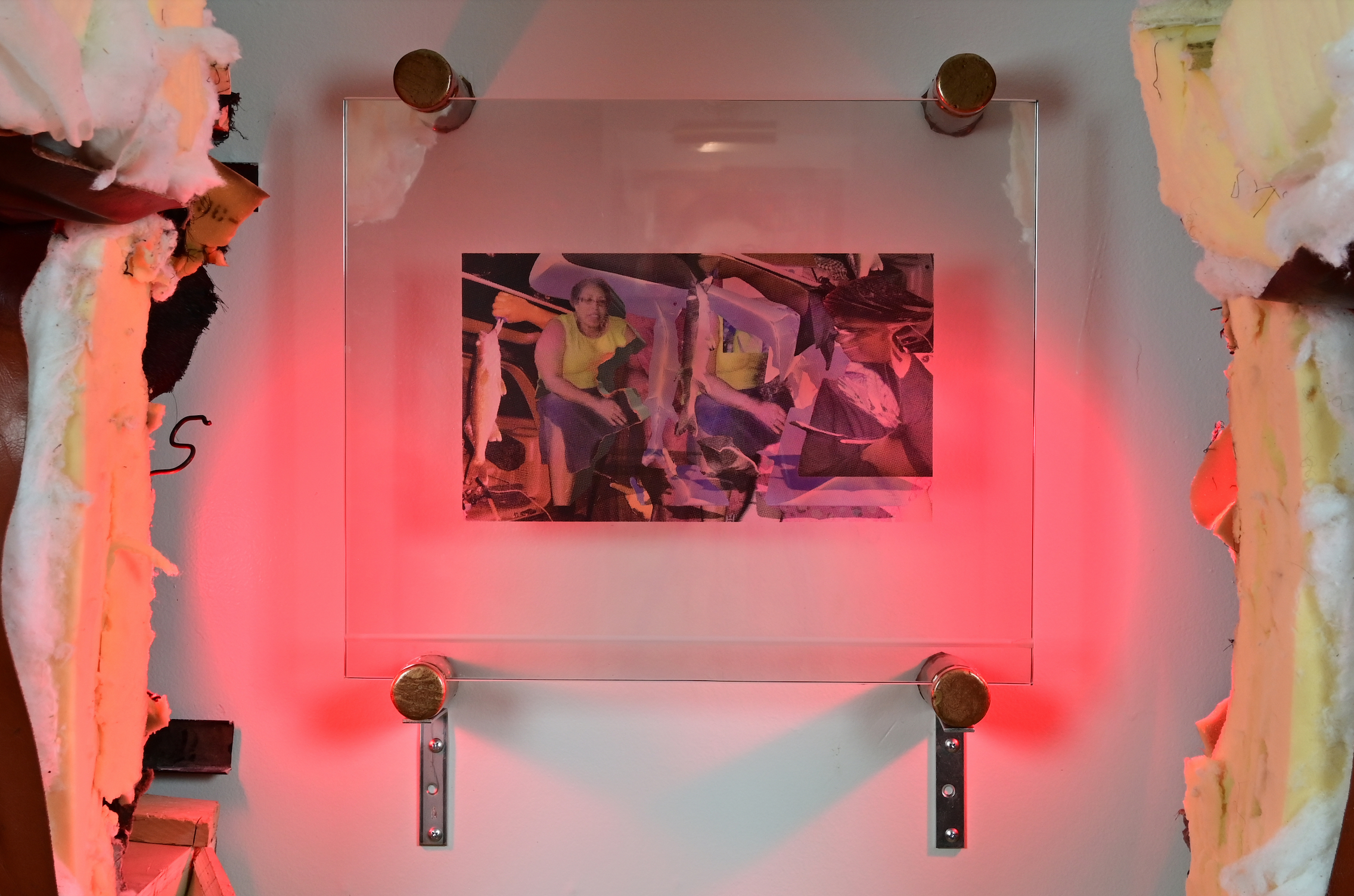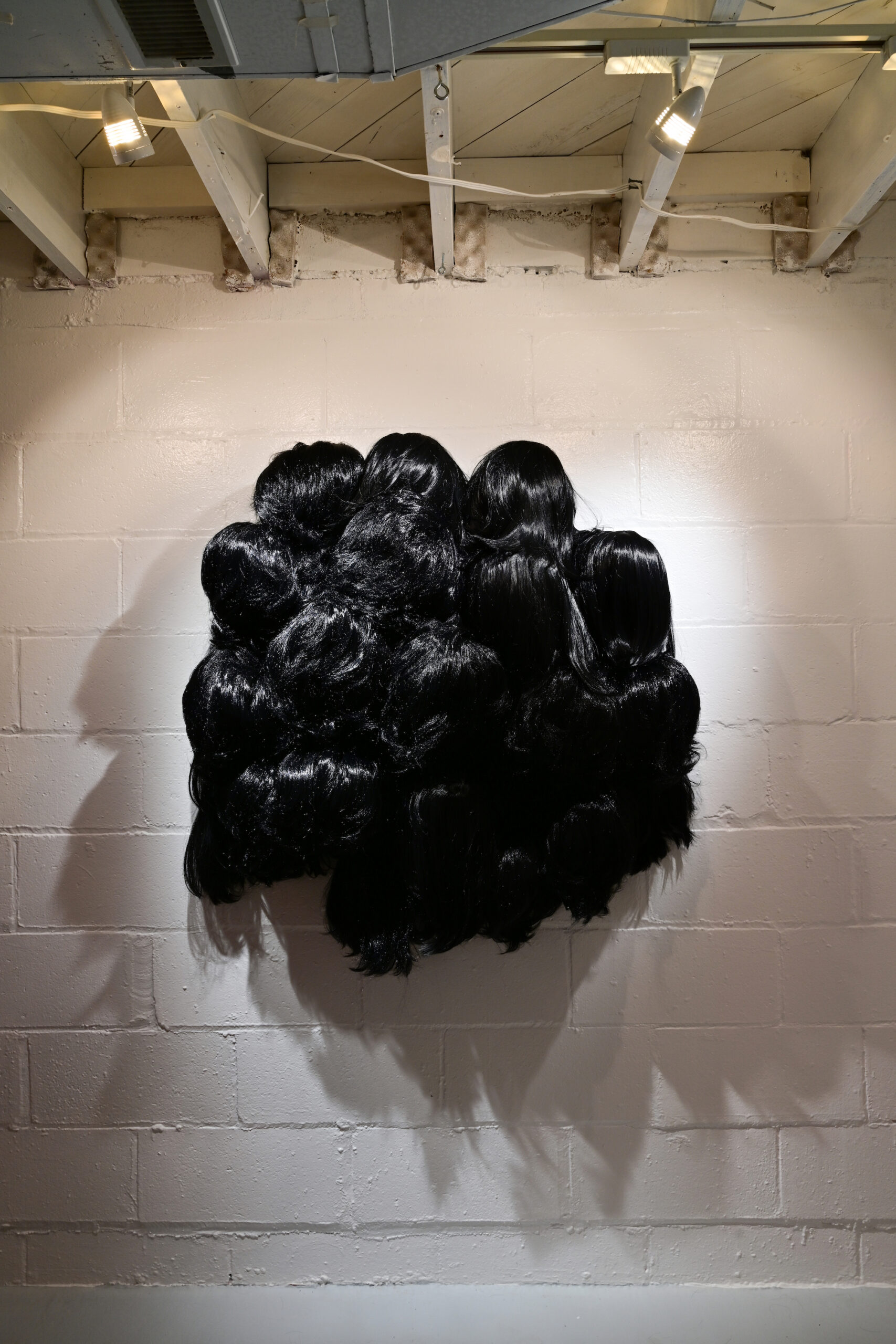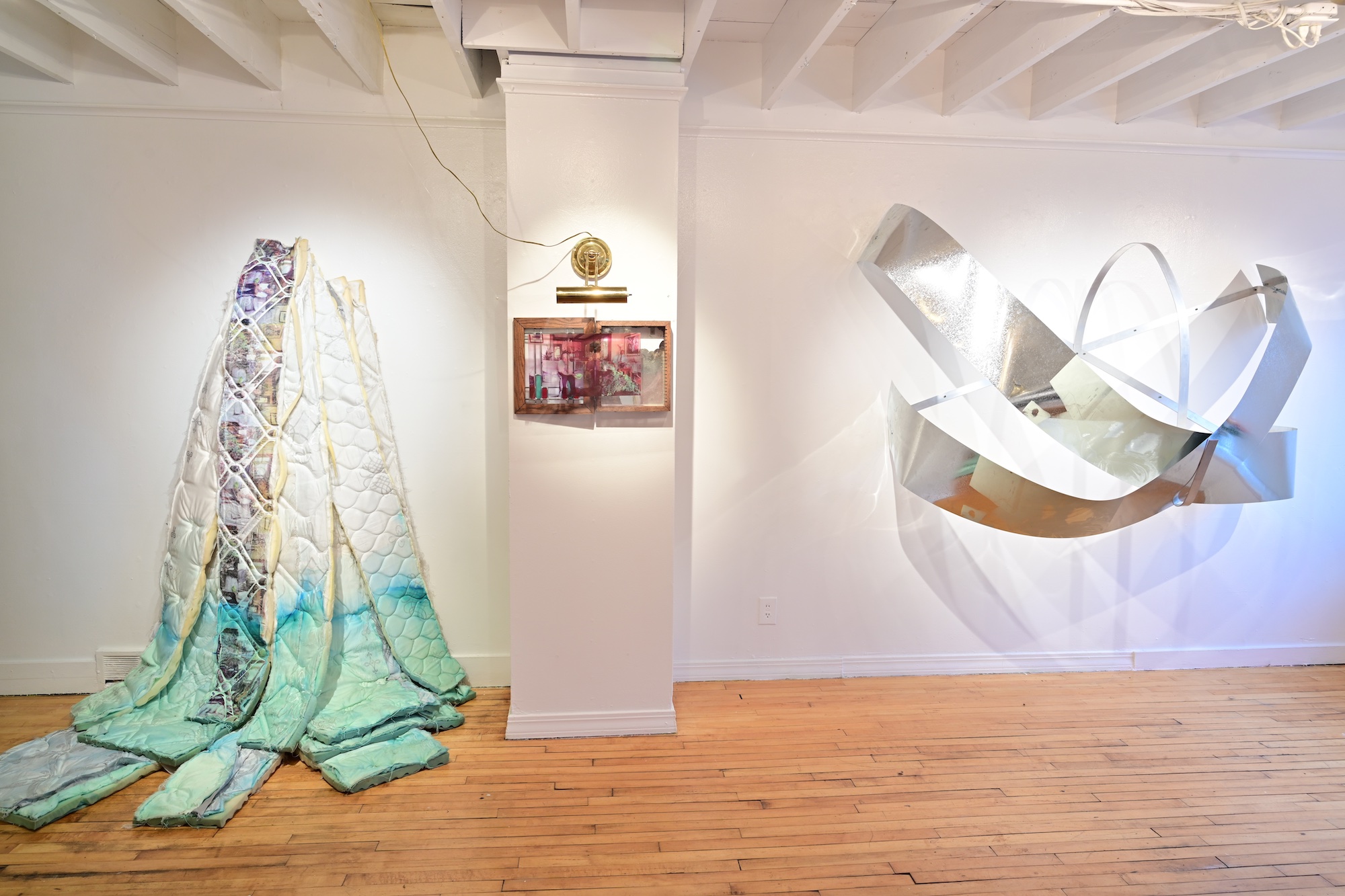Cameron Downey: Lord Split Me Open
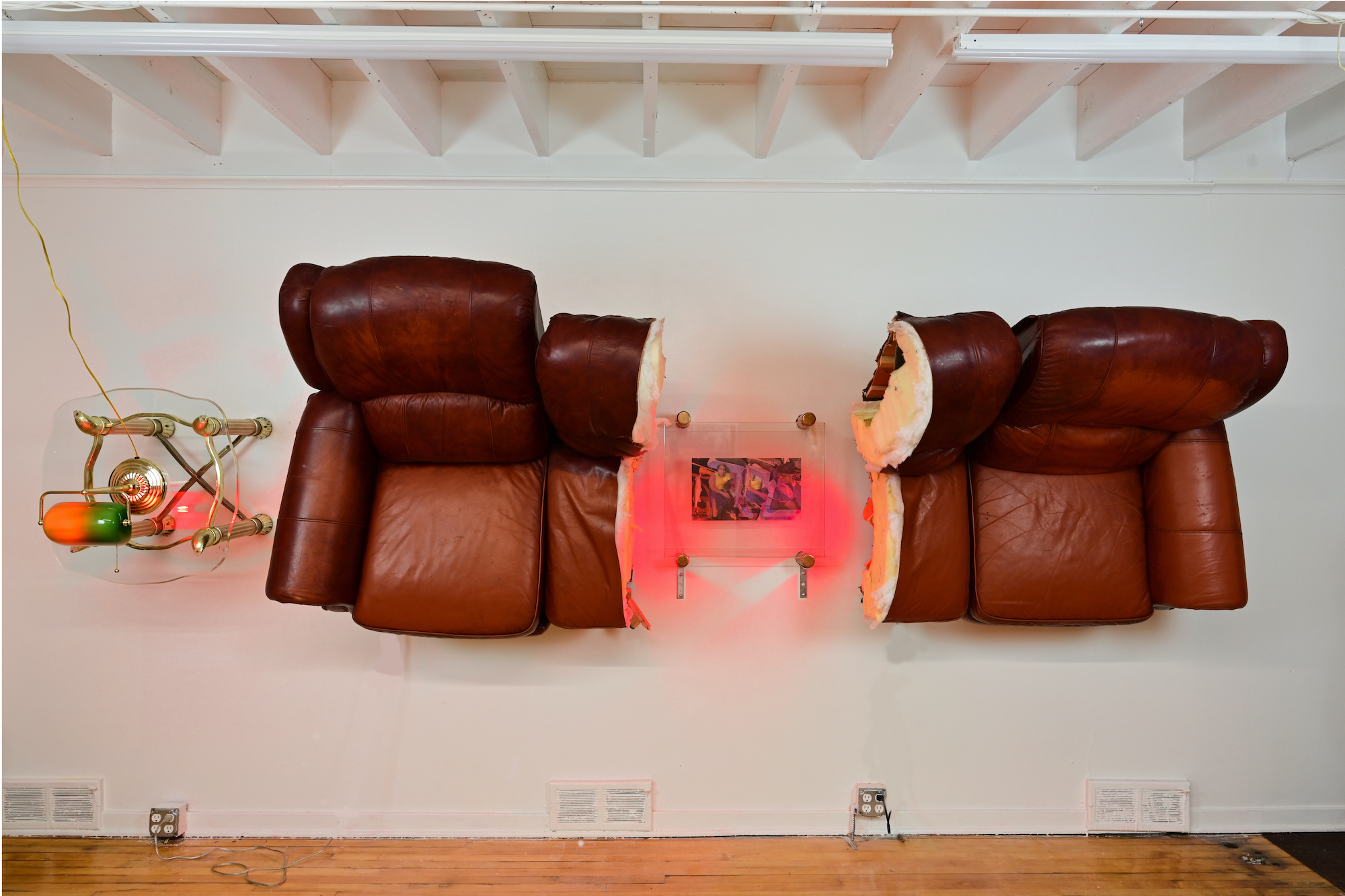
Cameron Patricia Downey, Lord Split Me Open, installation view, 2023 [photo: Emma Beatrez; courtesy of the artist and Hair + Nails, Minneapolis]
Share:
Lord Split Me Open is Cameron Downey’s first major solo exhibition. The show comes on the heels of other recent milestones: In 2021, they were featured in group exhibitions in Chicago and Berlin; that same year, the Walker Art Center acquired Hymn of Dust, a VHS film Downey produced with a collective of artists when they were a teenager. Their presentation at Hair + Nails—an artist-run gallery in south Minneapolis, which has championed their work since 2019—marks another big moment for Downey, who grew up in North Minneapolis. The gallery’s opening swelled with people, pushed into closer proximity by an inverted couch that hangs from the wall, establishing the rules—or lack thereof—of Downey’s world building.
Downey calls their practice “anti-disciplinary,” and refuses to shrink themself to fit into traditional artistic disciplines. Their application of “anti” is more expansive than oppositional, though, and Lord Split Me Open demonstrates Downey’s deftness in blending mediums. Combining sculpture and photography, for instance, Loving to beat the sky (2023) meets visitors at the gallery’s entryway with a cloud-like twist of aluminum and steel. Upon closer inspection, two just-legible images appear; as with several of the exhibition’s other sculptural works, Downey screen-printed photographs onto this glossy surface, the images culled from a decade-old camera they had used to record their family’s goings-on. Deeper into the gallery, Downey frames a video installation with dozens of white tank tops, signaling the artist’s ability to turn familiar objects strange. The four-minute loop flickers between glimpses of a shimmering lake and tender, slowed-down scenes of friends gathering. As the video runs, a soundtrack composed by Downey plays sampled songs, bits of conversation, and snippets from a sermon broadcast on KMOJ—a local radio station they listened to faithfully while growing up. Although these two works build upon a theme concerning the opacity of memory, to make strict connections between individual works hardly seems the best way to approach Downey’s debut. Instead, what visitors witness is an artist freely shifting between shapes and associations to assert their original visual language.
Cameron Patricia Downey, Loving to beat the sky, 2023, ink, aluminum, steel, 48 x 80 x 38 inches [photo: Emma Beatrez; courtesy of the artist and Hair + Nails, Minneapolis]
The exhibition’s linguistics recall the scholarship of Christina Sharpe, whose book In the Wake: On Blackness and Being seeks new means to make legible the fullness of Black life despite the global entrenchment of white supremacy. A concern of Sharpe’s is the impossibility of language as presently structured to hold both the ongoing subjection of Black life and the daily resistances that “exceed all of the violence directed at [it].” When addressing Blackness, she writes, “the meanings of words fall apart”—a tendency she terms “anagrammatical blackness.” As an example, she offers the word child, which forgets its meaning when the modifier Black is placed before it, given how Black children “are consistently seen as being older than they are.” Sharpe, however, implies that if language can be manipulated to reinscribe violent narratives, it can also be rearranged for liberatory purposes. The titular word wake, for instance, becomes a location of both abjection and care when Sharpe employs the term to stand in, at various points, for the path of a slave ship, keeping watch over those who have passed, or a current without defined end.
The freedom with which Sharpe reorients words finds shared spirit in Downey’s reworking of ubiquitous materials, which the artist imbues with new properties and behaviors. Although the gallery’s provided list of works names familiar objects—“leather couch,” “carpet,” “mattress”—the exhibition brims with slippages between descriptors and the things themselves: the aforementioned couch is cut perfectly in two, carpet squares shine and warp, and shredded strips of mattress cascade. Lord Split Me Open confuses the language readily available to describe it to reflect a practice that is simultaneously anti-disciplinary and anagrammatical.
Like Sharpe’s written word, Downey’s visual language is devoted to the sanctity of ordinary Black life—or, as their artist statement reads, their work “strives to archive, unfurl, make-altar-of and bring fantasy to the Blues of Black life and relation.” Lord Split Me Open registers on a local level, too. Minneapolis’ physical environment has shaped Downey’s dialect. The exhibition’s steel and aluminum bring to mind the heavy industry situated in North Minneapolis, where metal fabricators and scrap recycling facilities have made the historically Black Northside community one of the region’s most polluted. This history is of particular concern to Downey, who identifies as an environmental scientist and who concentrated in visual art and environmental studies at Columbia University. But alongside their critical approach to ecology is a romantic one. In a previous interview with the Walker Art Center’s Jake Yuzna, Downey noted that what makes Minneapolis distinctive are “these special, private, lush, watery places where everything converges.” In the present exhibition, an altered photograph depicting Downey’s brother proudly holding a walleye conjures their emotional attachment to this landscape. Black Lake Bay Fish Fry (2023) borrows its title from the nearby lake where their family would fish. The image suggests a sanctuary, representing Downey’s investment in making both the wretched and fantastical parts of their city legible.
Cameron Patricia Downey, Black Lake Bay Fish Fry, 2023, ink, glass, resin, 19 x 23 inches [photo: Emma Beatrez; courtesy of the artist and Hair + Nails, Minneapolis]
In that same interview, Downey mentions that the home where they spent much of their childhood was an extension of the neighborhood, with church service sometimes hosted at the house. With its carpet, leather couch, and Auntie Readymade (2023)—a glass end table similarly suspended from the wall—the first floor of Lord Split Me Open resembles a living room, in which the opening reception’s crowd assembled like a congregation. But the gallery’s basement reveals a private dimension to Downey’s practice. After descending the stairs, visitors encounter a long red curtain shrouding the building’s boiler; whereas the pine, brackets, and screws used for installation are exposed upstairs, Downey’s decision to hide the boiler announces that the basement communicates in another register.
On the other side of the curtain, a collection of synthetic wigs masses in a spiral. With music from Downey’s video installation audible through the floorboards, Performer (2023) at first approximates a feeling of standing behind a choir. But the title is singular, implying instead a lone performer, perhaps at their dressing room’s vanity. The materials list indicates that an aluminum grill cover and wood prop up Performer, but neither is detectable through the densely layered wigs. In concert with the title, Downey’s concealing of these elements reminds me of the late Tina Turner’s offstage practice of handmaking her own wigs, painstaking labor visible only to those in her innermost circle. There are witnesses to Downey’s labor, too. Six silver gelatin prints line the wall opposite Performer. The prints are the sole works on view made before 2023, and all but one feature Downey’s dear friends, some of whom perform for the camera. Looking at each, I am reminded of the freedom that guides Downey’s practice, and I recognize that their comfort in experimentation is perhaps couched in the close community illuminated in the basement.
In the Bible, a splitting open of the earth occurs as a consequence of faithlessness, swallowing entire communities. Removed from its italics, “Lord, split me open” is a deeply personal refrain, too—a plea to be seen completely. Either usage makes for an apt title to Downey’s exhibition, which mirrors whole worlds and proclaims the arrival of a singular voice who, informed by the communities they grew up in, has constructed a language solely their own.
Cameron Patricia Downey, Performer, 2023, synthetic wigs, aluminum grill cover, wood, aerosol, 42 x 40 x 9 inches [photo: Emma Beatrez; courtesy of the artist and Hair + Nails, Minneapolis]
Cameron Patricia Downey, Lord Split Me Open, installation view, 2023 [photo: Emma Beatrez; courtesy of the artist and Hair + Nails, Minneapolis]
Michael Curran is an arts writer and curator living in Minneapolis. His essays and reviews have been featured in Mn Artists, Public Parking, MPLSART.COM, TEMP/reviews, and St. Olaf College’s Flaten Art Museum. He has curated programming at artist-run galleries including Waiting Room and Normal Residential Purposes, a pop-up installation space he organized in his backyard. With his collaborator Tom Bierlein, he was awarded a 2022 Early-Career Artist Project Grant from Forecast Public Art, through which they organized Area of Concern—a public program at Crosby Farm Regional Park in St. Paul, Minnesota, centered on ecological grief. He holds a B.A. in geography and urban studies from Macalester College.
